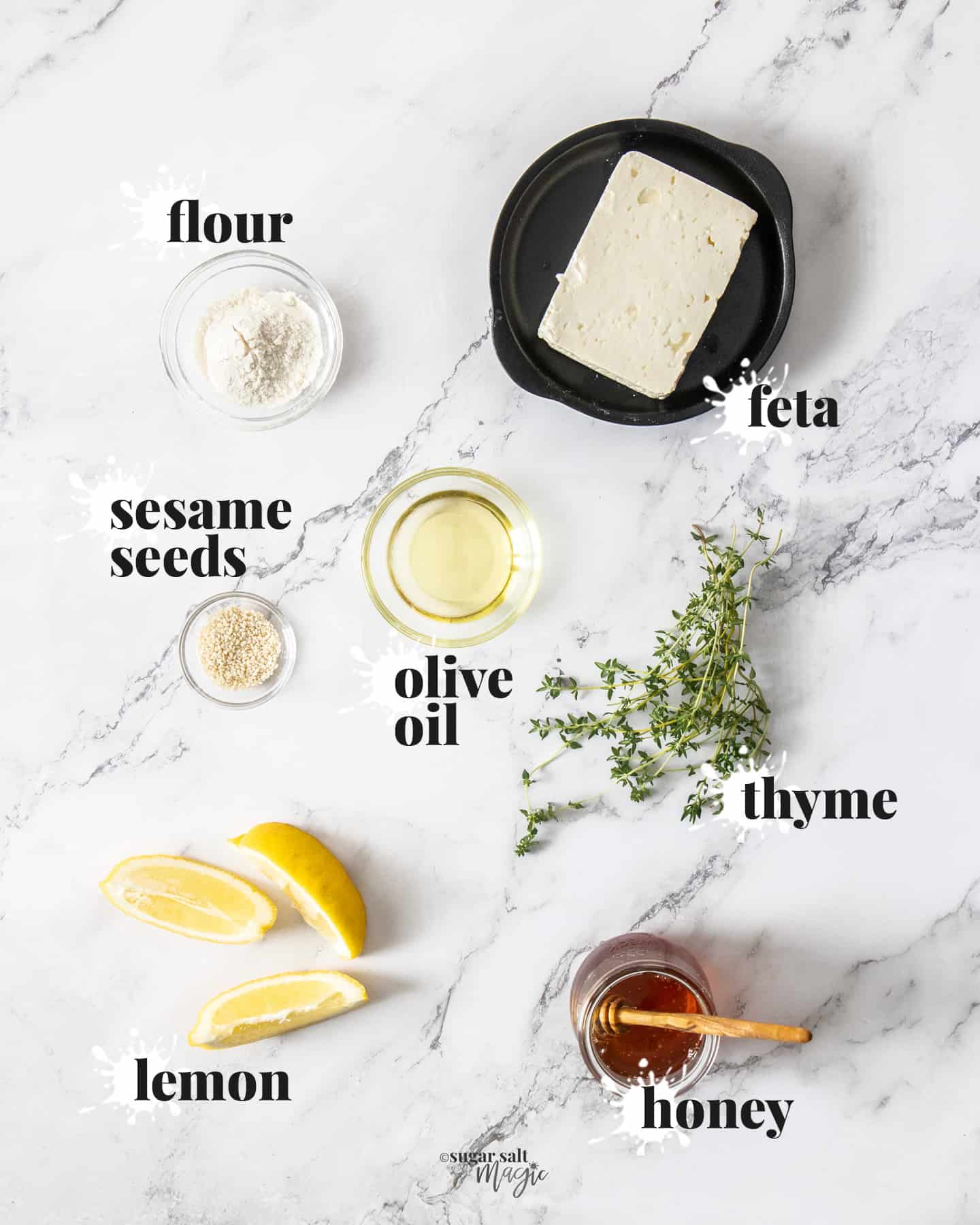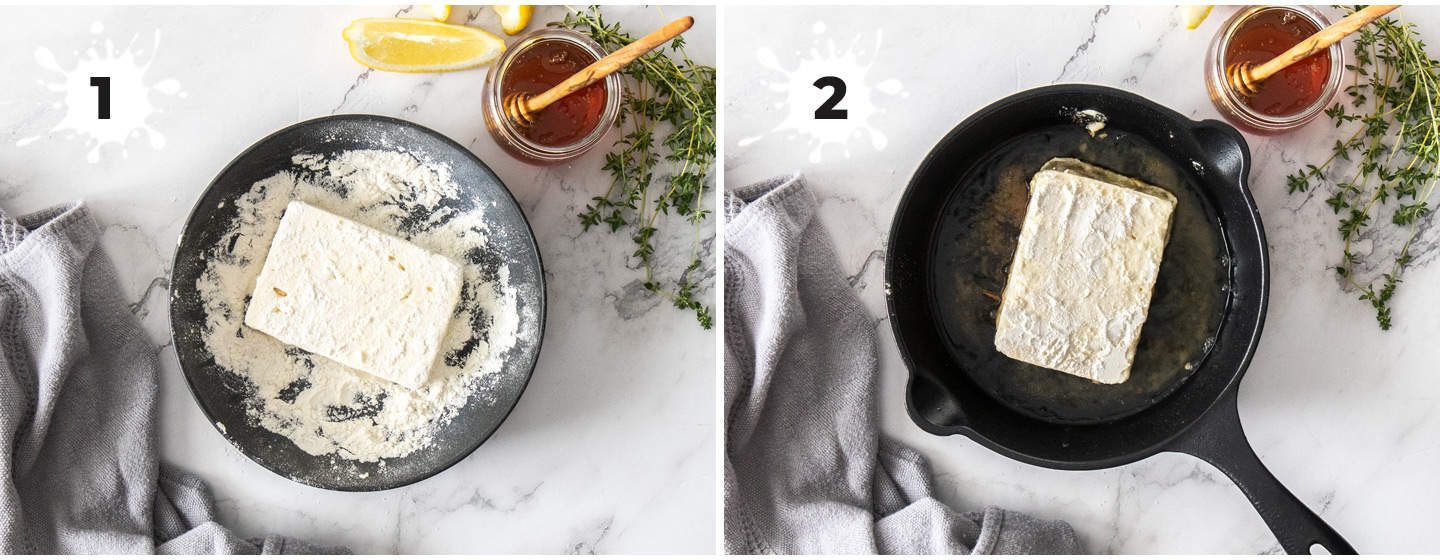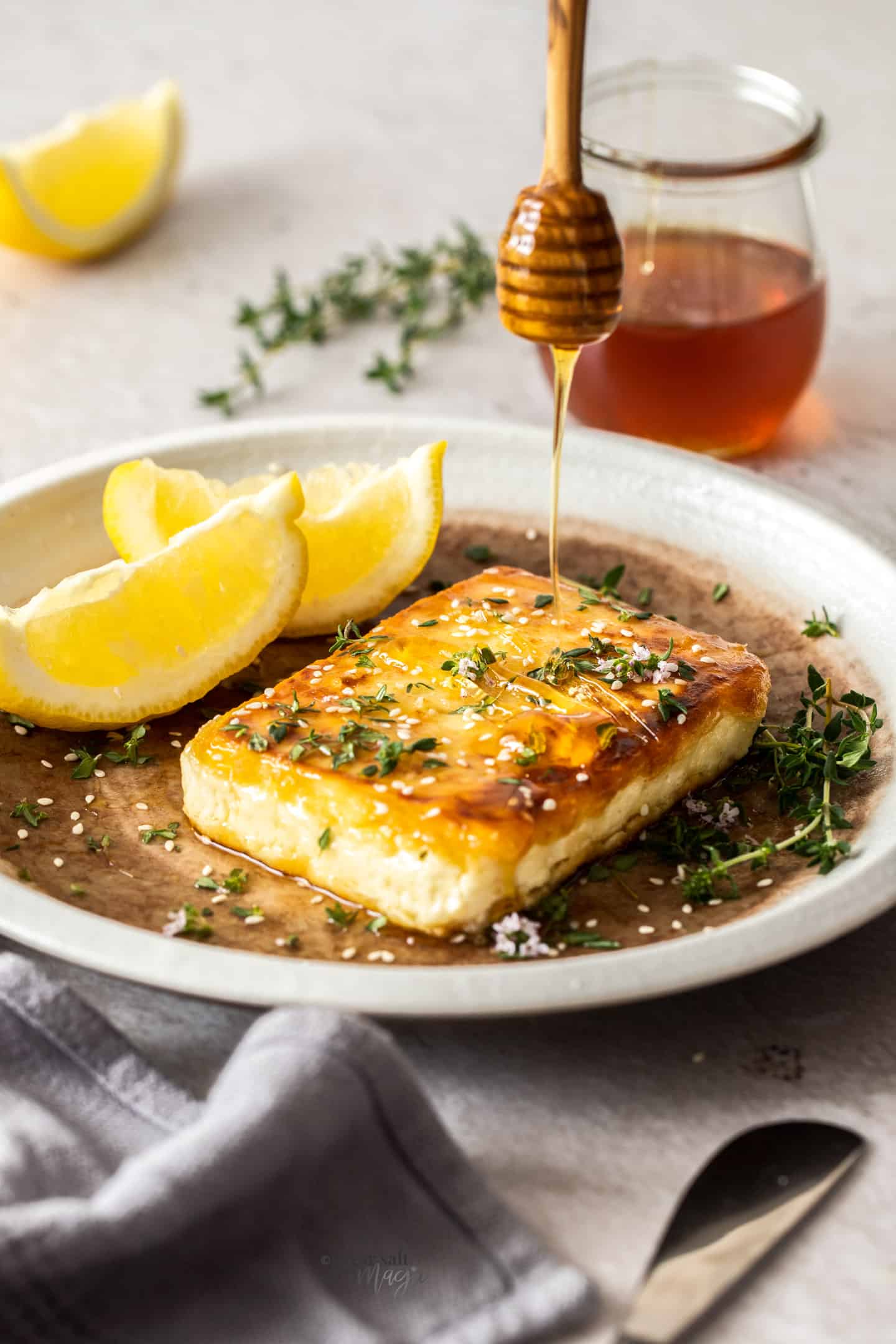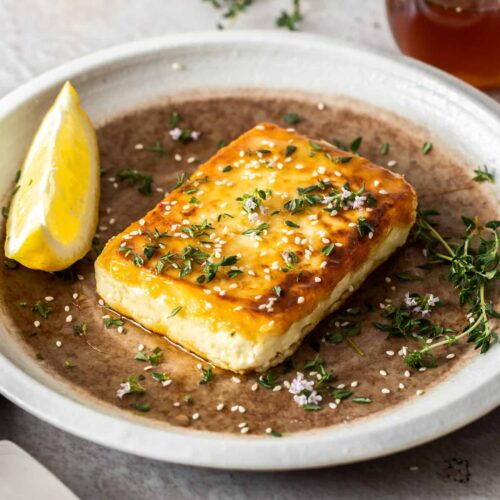Creamy pan-fried feta cheese with a golden crust is a delicious appetiser that’s ready in a flash. This feta saganaki, is served with a combination of lemon, honey, thyme and sesame seeds for the perfect salty-sweet combo.
Want more cheesy appetisers? Try this whipped goats cheese or these chorizo arancini.

Why you’ll love it
With the salty feta and sweet honey on top, this feta saganaki has a wonderful sweet and salty combo, perfect for entertaining. It’s incredibly quick to make and you technically only need 4 ingredients.
What is saganaki?
Saganaki is a classic Greek mezze dish, named after the pan it’s cooked in. This Greek fried cheese is cooked in a small two handled pan, similar to a skillet. This pan lends it’s name to other dishes too, like prawn / shrimp saganaki.
Traditionally, cheese saganaki is made with a Greek cheese called Kefalotyri or Kefalograviera that gets soft and gooey when its fried like this. It’s served immediately simply dressed with lemon juice.
If you use feta, like I have here, there are varying degrees of firmness. The one I’ve used is a smooth firm feta which gets nice and soft but not gooey. Try your favourite though you’ll need to be careful not to break the less firm versions when turning.
Tools you’ll need
- Small skillet or frying pan
- Flat spatula, like a fish slice for turning
Ingredients you’ll need
Technically you could get away with just 4 ingredients for feta saganaki – oil, feta, flour and lemon. I add a few more toppings for extra flavour and texture.

Detailed quantities and instructions in the recipe card below.
- Oil: Use good extra virgin olive oil for frying this cheese.
- Feta: I find a smooth firm piece of feta will work best and a thinner piece is better. Around 1 ½ cm (1/2 to 2/3 inch) thickness.
- Flour: You’ll need just a little plain (all-purpose) flour to coat the cheese so that it gets a crust when it fries.
- Lemon: Fresh lemon juice is the typical dressing for cheese saganaki.
- Honey: This saganaki has a little honey to add some sweetness to the salty cheese. This is optional and you can add as much or as little as you like.
- Thyme: Totally optional but I love sprinkling a little fresh thyme over the top.
- Sesame seeds: Often you’ll see saganaki coated in sesame seeds and fried. I’ve opted for just a little scattered over the top at the end.
How to make saganaki
Feta saganaki is the work of minutes. Just coat the feta in flour, then shallow fry until golden. The whole process takes 10 minutes.

Detailed instructions in the recipe card below.
- Coat the feta: Take the feta out of it’s packet but don’t dry it off. Toss it in some flour, making sure to press it on (photo 1).
- Fry the feta: Heat a little oil in a skillet then gently place the feta in (photo 2) so that it doesn’t splash the hot oil. Cook for 3-4 minutes until golden underneath, then carefully flip and repeat on the other side. Serve immediately.
I squeeze a little lemon then drizzle over honey. I garnish it with a little fresh thyme leaves and sesame seeds.
While some places will deep fry saganaki, there is no need to go to those lengths. It works lovely shallow fried and clean up is much easier.
The best cheese for saganaki
Kefalotyri, kefalograviera, kasseri and graviera are the traditional cheeses used. Feta (like this recipe) is often used also.
While some variations use halloumi too, it’s important to note, halloumi doesn’t get a soft or melty texture when it’s cooked, so the texture will be different.
Feta will not get melty or gooey but rather creamy and soft and with that crunchy coating, it’s all about those wonderful textures.

Tips and tricks
- There’s no need to dry the feta, just let excess liquid drip off, then coat in flour. The moisture will help the flour stick.
- If your feta is in brine, it may turn out extra salty, so rinse it off with water first, then let the excess drip off before coating in flour.
- Be very careful when adding and turning the feta in the pan so you don’t splash the hot oil. I like to use a flat spatula, like a fish slice to lift it and a fork on the other side to carefully turn it over.
- Serve immediately. Feta saganaki will firm up as it cools so serve it quickly to make the most of that warm, soft interior.
Should cheese saganaki be flambéed?
In some Greek restaurants, often in tourist areas, you’ll see them bring this flaming cheese to the table for serving and, while spectacular, it’s not traditional and can be dangerous.
I recommend NOT trying this at home but, if you do, please don’t use the same pan it is cooked in. It’s likely you’ll have an oil fire on your hands.
What to serve with saganaki
Traditional Greek saganaki is eaten as is, but as part of a mezze. Mezze is a selection of small dishes (similar to tapas) served often as appetisers, but you could certainly make a meal out of them. If serving on it’s own, I like to add some crackers, crusty bread or pita chips to eat it with.
You could serve things like olives, cucumber and tomatoes alongside. Dips like hummus or Greek eggplant dip would work well. Dolmades (stuffed grape leaves) and meatballs and octopus are other great Greek mezze additions.
You can also serve it as a starter to these Greek lamb kebabs (lamb souvlaki).

If you try this feta saganaki recipe, please take a moment to leave a rating and comment below. I love hearing from you and it helps other readers too! You can also take a photo and tag @sugarsaltmagic on Instagram.
More appetiser recipes you’ll love
- Baked feta and tomatoes
- Mini Lasagna Cupcakes
- Sesame Prawn Toast (Shrimp Toast)
- Olive Pesto
- Spinach Cob Loaf Dip
- Honey Grilled Prawns with Chorizo Dukkah
- Prosciutto wrapped dates
Never Miss a Recipe!
Get the latest recipes straight to your inbox!

Ingredients
- 200 g smooth firm feta (about 1 – 1 ½ cm thick)
- 1 ½ tablespoons plain (all-purp) flour (notes 1)
- 2 tablespoons olive oil (notes 1)
- 1 teaspoon fresh thyme leaves
- ½ teaspoon sesame seeds
- 1-2 tablespoons honey, to taste (notes 1)
- 2 lemon wedges
For best results, always weigh ingredients where a weight is provided
Equipment
- small skillet or frying pan
- Flat spatula, like a fish slice and a fork for turning.
Instructions
- Take the feta out of the package. If it was stored in brine you can rinse it first but don’t dry it off. Place it in a bowl with the flour and turn to coat, pressing the flour on to it as much as possible.
- In a small skillet, heat the oil over medium heat.
- Carefully place the feta into the oil, it should sizzle straight away, and cook 4-5 minutes, until deep golden underneath. Carefully, turn it over and repeat. If it looks like it’s colouring too quickly or starting to burn, turn the heat down a little.
- Once golden on both sides, transfer to a warmed serving plate. Squeeze over lemon, then sprinkle over the thyme leaves and sesame seeds. Drizzle honey to taste and serve immediately.
Notes
- I use a standard Australian 20ml tablespoon (equal to 4 teaspoons).
- Be careful when turning so as not to splash the hot oil. Slide a spatula underneath and hold a fork or another spatula on the other side.
- Serve immediately. Feta saganaki will firm up as it cools so serve it quickly to make the most of that warm, soft interior.
This post may contain affiliate links that earn me a small commission for my referral, at no extra cost to you. Thank you for supporting Sugar Salt Magic.




4 Comments on “Feta Saganaki”
This made a nice, quick side to lamb pita burgers (and both were great with some retsina). I only used lemon, no honey, and unfortunately, I forgot the thyme, which I’m sure would have added. Didn’t notice the sesame seeds. Maybe toast them next time?
The honey gives this a real sweet and salty flavour which is amazing. You could definitely toast the sesame seeds first for added flavour too.
Ooo this looks phenomenal! I love feta, but I’ve actually never heard / tried this recipe. It’s a must for me for sure!
If you love feta, you’ll definitely love this!